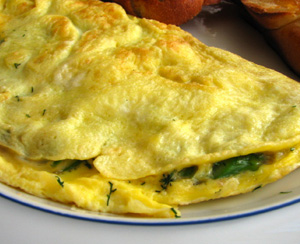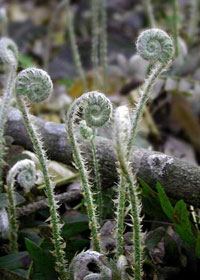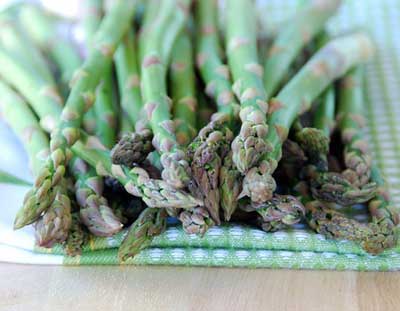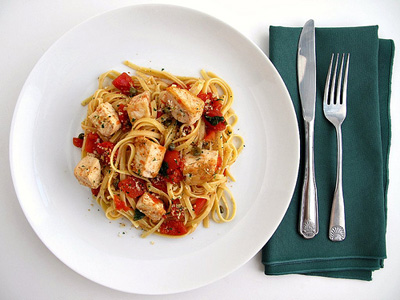 When my in-laws from Rhode Island were visiting recently, I mentioned that our strawberry season was coming to a close.
When my in-laws from Rhode Island were visiting recently, I mentioned that our strawberry season was coming to a close.
My mother-in-law said, "You mean it's starting, right?
"Nope," I said. "California's strawberry season usually starts in January and ends in June."
"But I don't understand. That's when our strawberry season is just starting," she said.
Exactly.
California is the advanced-gifted child in the classroom of strawberry production. The United States produces about 2 billion pounds of strawberries every year, 90% of which are grown here. Thanks to our temperate climate, we're able to produce strawberries in the wintertime and ship them across the country. That's why people in Massachusetts can buy fresh strawberries at the Stop & Shop in frigid February.
Spring
Spring
Spring Omelette
 The addition of fresh herbs breathes life into dishes. Herbs are vibrant, bright and introduce flavor that is so startlingly different from dried herbs that I can never understand recipes that imply they are interchangeable.
The addition of fresh herbs breathes life into dishes. Herbs are vibrant, bright and introduce flavor that is so startlingly different from dried herbs that I can never understand recipes that imply they are interchangeable.
In Italy I learned to make spaghetti with garlic, olive oil, chile flakes and parsley. It wasn't just the color contrast but the lively springiness of the parsley that made this simple dish so wonderful. Likewise sage leaves crisped up in butter or olive oil lend intensity and crunch, a handful of cilantro in a tossed green salad gives it a lemony zing and a sprinkle of chives on smoked salmon adds a delicate, almost sweet oniony flavor.
I have a little herb garden and I do mean little. A harvest of herbs from my window box is roughly equal to a generous garnish, so I have to keep raiding my mother's herb garden and buying herbs if I want to cook with them. Last week I got a chance to try Daregal fresh frozen herbs and found them to be surprisingly convenient and fresh tasting. I made a lovely omelette filled with asparagus and Jarlsberg cheese and a couple of pinches of Daregal frozen dill. This filling combination feels very Scandinavian to me though I have no idea if it really is...
Fiddleheads
 It wouldn’t be Spring in Maine without eating at least a couple “batches” of fiddleheads. This has been a record winter for snow and the melt has been gentle and slow until a few days ago when it rained for twenty-four solid hours! Since fiddleheads grow along the banks of waterways they literally disappeared until the waters receded. Interesting vegetable, huh?
It wouldn’t be Spring in Maine without eating at least a couple “batches” of fiddleheads. This has been a record winter for snow and the melt has been gentle and slow until a few days ago when it rained for twenty-four solid hours! Since fiddleheads grow along the banks of waterways they literally disappeared until the waters receded. Interesting vegetable, huh?
There are two varieties of ferns that are most desirable to eat, the cinnamon fern, a smaller more compact variety, which arrives first, and then the more prized ostrich fern, larger in size and more elegant in flavor. Fiddlehead ferns have a flavor like nothing else. They taste something like the fresh tips of asparagus with the texture of okra. You either like it immediately or you don’t. There is no middle ground or negotiation with this vegetable. Period.
The banks of rivers are covered with people picking huge bags and baskets of this spring delight in large quantities. My sister and I call them the stolen vegetable. No one ever picks their own from their land; it is always people sneaking onto your land and wiping out the fiddlehead crop till next year.
How to Select, Store, and Cook with Asparagus
 It's May 12th, and asparagus season is nearly over here in Southern California. While the majority of the country enjoys asparagus from April to June, our season usually stretches from late February to early May.
It's May 12th, and asparagus season is nearly over here in Southern California. While the majority of the country enjoys asparagus from April to June, our season usually stretches from late February to early May.
I'm not sad though -- this season's asparagus has been superb. The smooth, svelte green stalks with delicate purple tinged tips have had a mildly earthy flavor and deliciously tender texture. Since I've been buying two bunches of asparagus nearly every week for the last two months, I've learned a few things, So here are some tips on how to select, store, and cook with asparagus.
How to select asparagus: What's better, thin or thick stalks of asparagus?
Both. No, that's not a typo. Every spring there is an endless debate over which is better, thin or thick stalks. Most people swear thick asparagus stalks are tough. I disagree. I have eaten many tender and flavorful thick stalks of asparagus. What' really important is the quality of the stalk: look for straight, firm green stalks with light purple tinged tips. Look at the bottoms of the stalks. If they're white, dry, and woody, then they're probably old. Also avoid shriveled, overly dry, or pitted stalks.
Linguine with Swordfish in Quick Tomato Sauce
 Every Friday night I like to do pasta night. I love pasta dishes because they're quick to make and so satisfying to eat. And they don't at all need to be complicated. Sometimes all you need are a few pantry staples like canned tomatoes, capers, or olives to make a delicious sauce that doesn't take hours to cook. That's the true appeal of pasta.
Every Friday night I like to do pasta night. I love pasta dishes because they're quick to make and so satisfying to eat. And they don't at all need to be complicated. Sometimes all you need are a few pantry staples like canned tomatoes, capers, or olives to make a delicious sauce that doesn't take hours to cook. That's the true appeal of pasta.
Oftentimes when I don't feel like eating meat I'll whip together a vegetarian-style pasta or I'll make a quick Carbonara. Other times I'll make pasta with fish, adding seared cubes of fish to finish cooking in the sauce—you'd be surprised how wonderful fish is with tomato sauce. This recipe for pasta with swordfish is one of my favorites.
The best part about this recipe is that you use one pan (not including the pasta pot). Start by making the lemon and parsley crumb topping. Then wipe out the pan and sear the fish. And finally make the sauce and cook the pasta. Once it's all done, add the fish back to the pan along with the pasta to let the flavors mingle. Serve the pasta sprinkled with the crumbs instead of grated Parmesan, since cheese on fish is frowned upon by Italians (and I happen to agree with that assessment). Enjoy this dish for dinner any night—it's also great for Lent.
More Articles ...
Welcome to the new One for the Table ...
Our Home Page will be different each time you arrive.
We're sure you'll find something to pique your interest...
